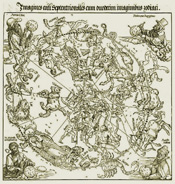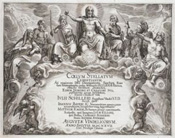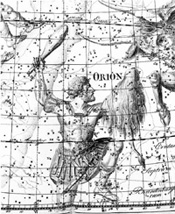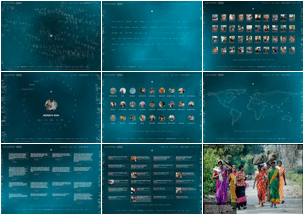Whether we live in a city, where the night sky bleeds orange with the glow of cars and buildings, or whether we live in the country, where the night sky is pitch black, punctured by myriad tiny points of light, we have all, on a dark night, tilted our head back and looked up. Most of us can spot the North Star, the big dipper, and the three-star belt of Orion the Hunter. With some more practice, we can see Pisces, Pegasus, and the Gemini twins. Each night, the great stories of ancient Greek mythology are played out in the sky — Perseus rescues Andromeda from the sea monster; Orion faces the roaring bull; Zeus battles Cronos for control of Mount Olympus. Most of us know the sky holds these great myths, immortalized as constellations. Slightly less well known are the newer constellations, largely added in the 18th and 19th centuries. These more modern constellations reflect a different sort of mythology — a commemoration of art and science, expressed through star groups representing technical inventions like the microscope, the triangle, the compass, the level, and the easel.


If we were to make new constellations today, what would they be? If we were to paint new pictures in the sky, what would they depict? These questions form the inspiration for Universe, which explores the notions of modern mythology and contemporary constellations. It is easy to think that the world today is devoid of mythology. We obsess over celebrities, music, movies, fashion and trends, changing madly from one moment to the next, causing our heroes and idols to come and go so quickly that no consistent mythology can take root. Especially for those who don't practice religion, it can seem there is nothing bigger in which to believe, that there is no shared experience that unites the human world, no common stories to guide us. Because of this, we are said to feel a great emptiness.

Universe is a system that supports the exploration of personal mythology, allowing each of us to find our own constellations, based on our own interests and curiosities. Everyone's path through Universe is different, just as everyone's path through life is different. Using the metaphor of an interactive night sky, Universe presents an immersive environment for navigating the world's contemporary mythology, as found online in global news and information from Daylife. Universe opens with a color-shifting aurora borealis, at the center of which is a moon, and through which thousands of stars slowly move. Each star has a specific counterpart in the physical world — a news story, a quote, an image, a person, a company, a team, a place — and moving the cursor across the star field causes different stars to connect, forming constellations. Any constellation can be selected, making it the center of the universe, and sending everything else into its orbit.
Universe is divided into nine "Stages", titled: Stars, Shapes, Secrets, Stories, Statements, Snapshots, Superstars, Settings, and Time. Stars presents a cryptic star field; Shapes causes constellation outlines to emerge; Secrets extracts the most salient single words and presents them to scale; Stories extracts the sagas and events; Statements extracts the things people said; Snapshots extracts images; Superstars extracts the people, places, companies, teams, and organizations; Settings shows geographical distribution; Time shows how the universe has evolved over hours, days, months, and years. In the top left corner is a search box, which can be used to specify the scope of the current universe. The scope can be as broad as 2007, as recent as Today, as precise as Vermont on August 27, 2006, or as open-ended as War, Climate Change or Happiness. The exact parameters of each universe are entirely up to the viewer, and unexpected paths unfold with exploration.
Universe does not suggest a single shared mythology. Instead, it provides a tool to explore many personal mythologies. Based on the chosen path of the viewer, Universe presents the most salient stories, statements and snapshots, as found in global news coverage from thousands of sources. Through this process of guided discovery, patterns start to emerge. Certain stories show up again and again, and they become our great sagas. Certain people start to shape the news, and they become our heroes and villains. Certain single words rise from the chatter, and they become our epic themes.
In Universe, as in reality, everything is connected. No event happens in isolation. No company exists in a vacuum. No person lives alone. Whereas news is often presented as a series of unrelated static events, Universe strives to show the broader narrative that contains those events. The only way to begin to see the mythic nature of today's world is to surface its connections, patterns, and themes. When this happens, we begin to see common threads — myths, really — twisting through the stream of information.
- Jonathan Harris
February 2007, Brooklyn, New York


